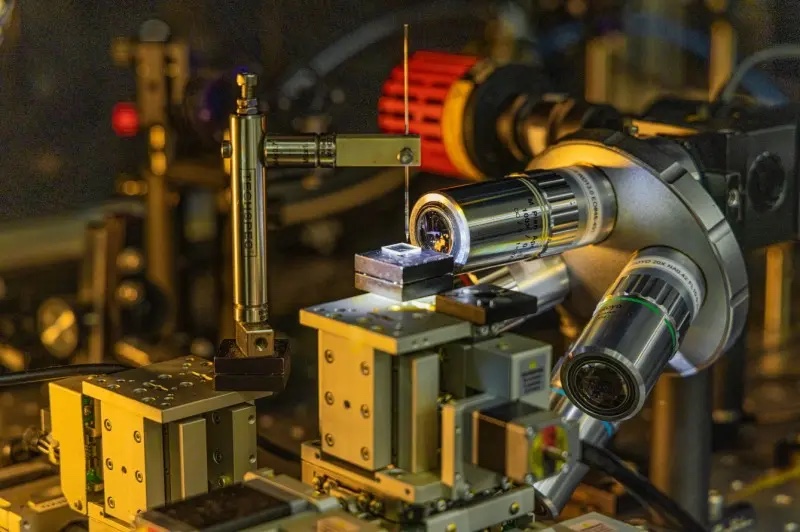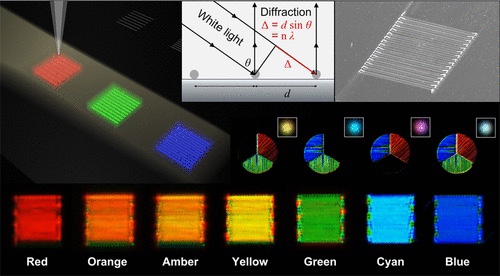In June, 2023, the materials science journal ACS Nano published a study by a research team at the Korea Electrotechnology Research Institute (KERI), on the development of 3D printing technology capable of producing transparent displays optimized for augmented reality (AR) devices. Entitled “Three-Dimensional Printing of Structural Color Using a Femtoliter Meniscus”, the study was conducted as part of a larger KERI project, “Development of 4D printing technology for circuit/housing integrated devices.”
The operation of meniscus-guided 3D printing is somewhat easier to understand than its frighteningly complex-sounding name might suggest. First off, a ‘meniscus’ in this context is a curve formed when tension is created between the liquid in a container and the liquid that the container has dispensed onto a surface.

Second, a ‘femtoliter’ is a measurement equating to one-quadrillionth of a liter, highlighting the key detail relevant to this particular area of the additive manufacturing (AM) sector, which is that these techniques work because they happen at the nanoscale. The KERI team developed its method using a nanopipette combined with direct ink writing (DIW) 3D printing, which allowed the researchers to deposit polymer ink onto a variety of different substrates such as quartz, silicon, and platinum.
The goal of the study was to achieve the end-result of structural color on the finished displays. In nature, structural color is seen in things like chameleon skin, where the appearance of surface hues changes due to the interaction of light wavelengths with the microstructures at hand. In this case, the purpose of 3D printing to manipulate this process is to control color patterns without using dyes, which is essential, for one thing, because of the objective of creating a transparent end-product.

Components designed to achieve structural color — known as ‘diffraction gratings’ — are increasingly common in the optics industry, and are particularly instrumental to the burgeoning manufacture of AR and virtual reality (VR) hardware. Hence the team’s claim that it has developed the “world’s first” AM process for AR-specific displays, a claim I can’t vouch for, but I can certainly affirm that this is one of the most unique 3D printing methods I’ve stumbled across.

It is also something of a raison d’être for KERI, where years have been spent building up the technology for this exact purpose of transparent displays. The team that worked on this leg of the project has already filed the patent application, and in addition to the AR/VR industry, the researchers also anticipate that their findings will be relevant to the manufacture of things like environmental sensors and anticounterfeiting methods.
A non-profit funded by the South Korean government, KERI has multiple locations, including a headquarters in the southeastern coastal city of Changwon, home to “70% of South Korea’s defense industry”, as well as a number of manufacturing facilities for the nation’s largest corporations. Thus, there are more than a few potential customers right at KERI’s doorstep who have likely already shown interest in this R&D breakthrough.
That does not even include Apple, which in June held its first-ever Smart Manufacturing Forum in Pohang, South Korea, less than 100 miles from KERI. That event was part of an initiative forced on Apple by the Korea Fair Trade Commission, whereby the company agreed to share details with South Korean small and medium enterprise (SME) manufacturers as part of a payment of a fine dating back to 2021.
Apple, of course, recently announced the upcoming release of its first VR headset. In July, it was also reported that the company will be using metal AM for the next generation of the Apple Watch Ultra. That is obviously a product that 3D printed displays could eventually be quite useful to. Meanwhile, Meta acquired Luxexcel at the end of last year in order to 3D print lenses for its own AR and VR efforts.
Unless otherwise noted, images courtesy of Display Daily
Subscribe to Our Email Newsletter
Stay up-to-date on all the latest news from the 3D printing industry and receive information and offers from third party vendors.
You May Also Like
Gorilla Sports GE’s First 3D Printed Titanium Cast
How do you help a gorilla with a broken arm? Sounds like the start of a bad joke a zookeeper might tell, but it’s an actual dilemma recently faced by...
Nylon 3D Printed Parts Made More Functional with Coatings & Colors
Parts 3D printed from polyamide (PA, Nylon) 12 using powder bed fusion (PBF) are a mainstay in the additive manufacturing (AM) industry. While post-finishing processes have improved the porosity of...
$25M to Back Sintavia’s Largest Expansion of Metal 3D Printing Capacity Since 2019
Sintavia, the digital manufacturing company specializing in mission-critical parts for strategic sectors, announced a $25 million investment to increase its production capacity, the largest expansion to its operations since 2019....
Velo3D Initiates Public Offering in a Bid to Strengthen Financial Foundations and Drive Future Growth
Velo3D (NYSE: VLD) has been among a number of publicly traded 3D printing firms that have attempted to weather the current macroeconomic climate. After posting a challenging financial report for 2023,...































